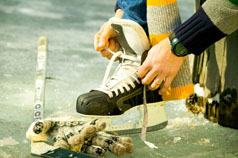Ice & Cold Weather Safety Tips

Each year, many residents are injured during the winter months as a result of pedestrian accidents and from exposure in cold water incidents. Skaters fall through the ice; boaters and canoeists overturn their crafts and pedestrians are struck walking in roadways because sidewalks are snow covered.
Here are a few general guidelines for use by winter recreation enthusiasts to lessen their chances for an icy dip or worse. It's impossible to judge the strength of ice by its appearance, thickness, daily temperature, or snow cover alone. Ice strength is also dependent on water depth under the ice, the size of the water and water chemistry, currents, and distribution of the load on the ice.
THE ONLY "SAFE" ICE IS AT A SKATING ARENA!
WHAT DO YOU DO IF SOMEONE FALLS THROUGH THE ICE?
- Act quickly and call 9-1-1 for help immediately. Make sure properly trained and equipped rescue personnel are alerted to respond.
- DO NOT go out onto the ice. Many times would-be rescuers become victims themselves.
- Reach, Throw, or Row. Extend a branch, pole or ladder to the victim. Throw them a buoyant object such as a life ring or float tied to a rope. If a boat is nearby row out to the victim or push it toward them.
HOW COLD IS COLD WATER?
- Any water that is cooler than normal body temperature (98.6 degrees F) is by definition "cold water"
- Cold water drains away body heat 25 to 30 times faster than air!
- The lower the temperature of the water, the faster the onset of hypothermia.
WHAT IS HYPOTHERMIA?
- Hypothermia is the excessive lowering of body temperature. A drop n core temperature below 95 degrees F., causes shivering, confusion, loss of muscle strength, and if not treated and reversed leads to unconsciousness and death.
- Safety experts estimate that half of all drowning victims die from the fatal effects of hypothermia and cold water, not the fatal effects from water filled lungs.
PEDESTRIAN SAFETY
- Slippery driveways and sidewalks can be particularly hazardous in the winter. Keep them well shoveled, and apply materials such as rock salt or sand to improve traction.
- Be especially careful crossing the street and wear appropriate shoes and brightly colored (not white) clothing while walking in snowy conditions.
- Use reflective clothing or stickers for maximum protection, especially at dawn and dusk.
